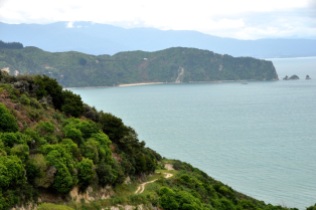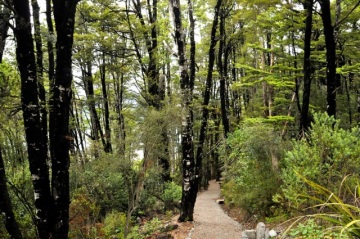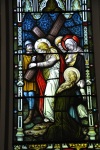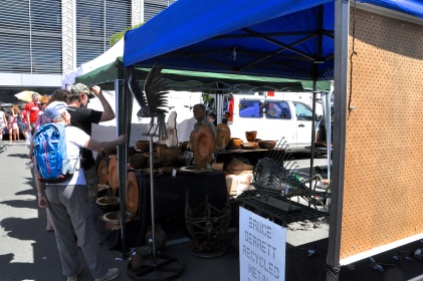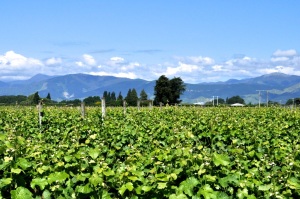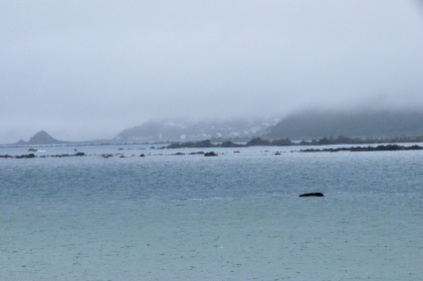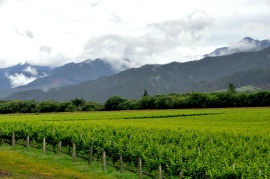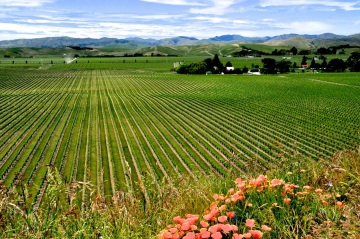Abel Tasman is NZ’s smallest national park but has an international reputation that draws tons of visitors, mostly to see the coastline. My guidebook says it is fabulously beautiful, with golden sandy beaches, crystal-clear water, lush bushland, granite outcrops and an abundance of wildlife. Most people hike and kayak and swim and snorkel along the coast, and most of this occurs from the very accessible east side. We plan to do that too, but for now we’re going to do the road-less-traveled and hike Abel Tasman from the west side, as well as visit Golden Bay. Golden Bay is at the northwest tip of the South Island, and is backed by the mountains of Kahurangi National Park on 3 sides, with the bay on the 4th. It is far less accessible, with access in or out being a single, very narrow, very twisty road over a mountain called “Takaka Hill”. Some hill. Oh, and because it’s the only road supplying some 6 towns, there’s truck traffic. LOTS of truck traffic. LOTS of very BIG truck traffic! Not to mention lumber trucks carrying big tree sections. Luckily, we don’t know this, so off we go. It’s 70 miles away; later, when we look it up, travel time is estimated to be 2 hours. There is not one straight stretch of road. The steering wheel is either hard right or hard left, with very little time between the two positions. A couple of times on severe switchbacks I was afraid I might rear-end myself. It is, however, quite pretty. Stopping is usually out of the question, but there are a few spots to pull over. Alas, I have the camera on the wrong white balance setting, and the pictures are impossibly blue. Here is one shot going in, and another at the same location
on the way out days later. NZ is amazing in its ability to have the same view be mesmerizingly and captivatingly different from one moment to the next.
Coming down Takaka Hill, the Golden Bay ocean (left image) and plain (right image) are
gorgeous, although it’s hard to tell from the Picasso Blue Period I’m in. Closer to the bottom of the hill, without the blue, you can see that this is a pretty place.
These pictures are from the valley floor near the city of Takaka.
Well, as luck would have it, our plans to kayak and horseback ride on Golden Bay are quashed – the continuous lean-in and lean-out jostling as we wound up and down Takaka Hill have done a number on Ginger’s neck; she can hardly turn it, so we’ll have a few quiet days instead. She does mention, in a gentle way, that perhaps we might take the curves a little bit more slowly the next time (in my defense: we pulled over more times than numerous to let faster cars go by; but the lady makes a strong argument!).
We’re holed up in a cottage outside of town up a gravel road and on a hill. It’s a simple place with spectacular views (and a lot of spiders, but we rectify that). Staying here isn’t so bad. Nearest neighbors are sheep, which come regularly to inquisitively check on us and to baaaaa quietly. Cows off in the distance give a far-away moooo. The “boring” view is straight ahead to the water of the bay, which changes color by the hour. The flax plants attract Tui, which visit throughout the day to feast on its nectar; Tui are amazing birds with their otherworldly, indescribable, transfixing sounds and amazing dark iridescent feathers set off by that white throat ornament. We love them.
The major delight is the ever-changing Provence-like light on the hills. The pastoral view is stunning, changing hour-by-hour from one stunning to a different stunning. The Impressionist painters would have given their left ear for this light. Not a bad place for us to crash. I’ll show you some examples below.
Wow. And wow again. Of course, the entire 180° view is better than the snippet shown here, but this gives you a good idea of the incredible beauty. I’ll also add a couple of pictures of the amazing shade-on-shade color from the layers of receding mountains.
Needless to say, the stars out here are also breathtaking. It’s hard to see stars in today’s overly lighted world, but here in the country darkness, looking at the blazing glory of the infinite universe, it’s beautiful and humbling. And guess what? Orion is upside down, standing on his head with his shield for balance, I guess. It would be interesting to see what the constellations would look like had they been drawn from the southern hemisphere.
As Ginger recovers, we take a short walk on one of the beaches. We choose a nearby beach  randomly, and we practically have it to ourselves. Another couple is strolling off in the distance, and a windsurfer is zooming around on this somewhat windy day. Kiwis do love their water sports! The water is swimming-pool cool, very comfortable for wading or swimming. One of the nice touches to a NZ beach is the combination of
randomly, and we practically have it to ourselves. Another couple is strolling off in the distance, and a windsurfer is zooming around on this somewhat windy day. Kiwis do love their water sports! The water is swimming-pool cool, very comfortable for wading or swimming. One of the nice touches to a NZ beach is the combination of
beach AND mountains. It adds to the viewing interest, although the rhythm and sound of the incoming waves don’t really need additional help for our enjoyment. Not to mention  the sea shells and pretty polished rocks and interesting driftwood from the very hard and dark wood of some of the NZ trees.
the sea shells and pretty polished rocks and interesting driftwood from the very hard and dark wood of some of the NZ trees.
At last Ginger is better, and we have time for a hike in Abel Tasman. We’re entering from the very tail end of the Coast Track. It’s an up-and-down hike to the first bay, Whariwharangi, and the “up” is probably the  highest climb of the entire Coast Track. The good news is that the grade is not especially steep. We’ll see how far we get.
highest climb of the entire Coast Track. The good news is that the grade is not especially steep. We’ll see how far we get.
We start from Wainui Bay, which is itself not too shabby (picture to left). The trail immediately starts climbing, giving a good overview of the bay, as shown below.
And the trail continues to climb.
The trail circles above a small bay, but there is no obvious way down to it.
We wind through what the Kiwis call “bush” – the original wild cover of NZ (left image below). The reasonably wide trail is mostly a single, or sometimes two, dirt footpaths in medium-tall grass (right image). The grass sometimes bends over, obscuring the footpath; it doesn’t seem to be a heavily used trail.
 The bush itself is interesting. It is solid, a mass. It would be hard to walk through without a path. The picture shows an adjacent hillside.
The bush itself is interesting. It is solid, a mass. It would be hard to walk through without a path. The picture shows an adjacent hillside.
The flowers along the trail are gay, bright and pretty. Most are small, but frequently one encounters impressive lupine (yellow or pink) and the commanding I-am-so-pretty
foxglove, in pink and in white.
Before we get to the top of the climb, Ginger decides she has had enough and turns back.  I’m convinced that the top is not far off, and decide to press ahead. Sure enough, the top is not far. This coastal track intersects with an inland track, and the trail is now considerably better – not just a footpath, it’s wide. Off in the distance is the ocean, and Whariwharangi Bay (shown below), and from here it’s all downhill. Close but no cigar. Another time. Gotta catch up with Ginger.
I’m convinced that the top is not far off, and decide to press ahead. Sure enough, the top is not far. This coastal track intersects with an inland track, and the trail is now considerably better – not just a footpath, it’s wide. Off in the distance is the ocean, and Whariwharangi Bay (shown below), and from here it’s all downhill. Close but no cigar. Another time. Gotta catch up with Ginger.
Next stop will be Nelson Lakes National Park, in the boonies. Time to do some real hiking!































